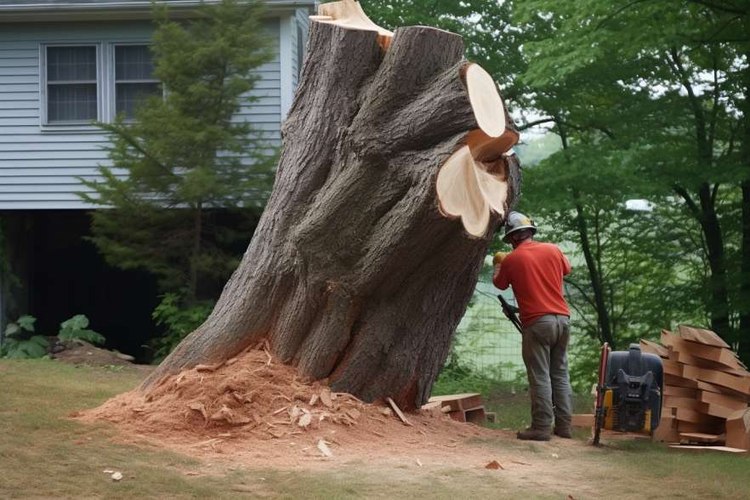Cost Considerations for Tree Removal Services
When considering tree removal services, understanding the associated costs is essential for homeowners. This article will break down the various factors influencing tree removal prices, including the size and location of the tree, the complexity of the job, and additional services like stump grinding and debris removal. By exploring these cost considerations, readers will be better equipped to budget for tree removal and make informed decisions when hiring professionals.

What Is the Average Cost For Tree Removal?
The average cost for tree removal in the United States typically ranges from $200 to $2,000 per tree, with most homeowners paying around $700 to $1,200 for standard removal services. However, these prices can fluctuate dramatically based on several key factors. Small trees under 30 feet generally cost between $200 and $400 to remove, while medium-sized trees ranging from 30 to 60 feet typically cost $400 to $800. Large trees over 60 feet can cost anywhere from $800 to $2,000 or more, especially if they require specialized equipment or pose significant safety challenges.
The complexity of the removal process significantly impacts pricing. Trees located near power lines, buildings, or other structures require more careful planning and specialized techniques, which increases labor costs. Emergency tree removal services, particularly after storms or when trees pose immediate safety hazards, often carry premium pricing due to the urgent nature of the work and potential after-hours service requirements.
How Do Tree Services In USA Compare by Region?
Tree services in USA vary considerably by geographic region due to differences in cost of living, local regulations, and regional tree species. Urban areas typically command higher prices than rural locations, with cities like New York, Los Angeles, and San Francisco often charging 20-40% more than the national average. Northern states may have higher costs during peak seasons due to shorter working windows caused by harsh winter weather conditions.
Regional differences also stem from local tree species and environmental factors. Areas prone to hurricanes or severe weather events often have more competitive tree service markets due to higher demand, which can both increase prices during peak seasons and create more competitive pricing during slower periods. Western states dealing with drought conditions and fire prevention may have different service focuses compared to areas in the Southeast dealing with storm damage and rapid tree growth.
Finding Tree Trimming Services Nearby
Locating quality tree trimming services in your area requires research and careful vetting of potential contractors. Start by seeking recommendations from neighbors, local nurseries, or hardware stores, as these sources often have firsthand experience with reputable local providers. Online review platforms can provide valuable insights into customer experiences, but be sure to read multiple reviews to get a balanced perspective on each company’s reliability and quality of work.
When evaluating local tree trimming services, verify that contractors carry proper licensing and insurance coverage. Many states require tree service companies to hold specific licenses, and all reputable companies should carry both liability insurance and workers’ compensation coverage. Request proof of insurance and verify coverage directly with the insurance provider when possible. Additionally, look for companies that employ certified arborists, as this demonstrates a commitment to professional standards and ongoing education in tree care practices.
Factors Affecting Tree Service Prices in Your Area
Multiple variables influence tree service pricing in your specific location. Tree size remains the most significant factor, but accessibility plays an equally important role in cost determination. Trees located in tight spaces, near structures, or requiring crane access will cost substantially more to remove safely. The tree’s health condition also affects pricing, as diseased or dead trees may be more unpredictable and dangerous to remove, requiring additional safety precautions.
Seasonal timing can impact pricing significantly, with spring and summer typically being peak seasons when demand and prices are highest. Fall cleanup services and winter storm damage create additional demand spikes that can affect pricing. Some companies offer off-season discounts during slower periods, making late fall or winter scheduling potentially more cost-effective for non-emergency situations.
Finding the Most Affordable Tree Service Options
When searching for cost-effective tree services, several major companies and local providers offer competitive pricing across different regions. Here’s a comparison of typical service providers and their general pricing structures:
| Service Provider | Service Type | Average Cost Range |
|---|---|---|
| Davey Tree | Full-service tree care | $300-$1,500 per tree |
| Bartlett Tree Experts | Professional arborist services | $400-$1,800 per tree |
| Local independent contractors | Basic removal services | $200-$1,000 per tree |
| Asplundh Tree Expert | Commercial and residential | $350-$1,600 per tree |
| Monster Tree Service | Franchise locations nationwide | $250-$1,200 per tree |
Prices, rates, or cost estimates mentioned in this article are based on the latest available information but may change over time. Independent research is advised before making financial decisions.
Additional Services and Hidden Costs
Beyond basic tree removal, several additional services can affect your total project cost. Stump grinding typically adds $75 to $400 to your bill, depending on the stump’s size and root system complexity. Debris removal and cleanup services may cost extra, with some companies charging additional fees for hauling away large amounts of wood and branches. Some contractors include basic cleanup in their initial quote, while others charge separately for this service.
Permit requirements in many municipalities can add unexpected costs to tree removal projects. Some cities require permits for removing trees over certain sizes or within protected areas, with permit fees ranging from $25 to $200 or more. Additionally, if utility line clearance is needed, coordination with local utility companies may be required, potentially adding time and cost to your project.
Understanding the various factors that influence tree removal costs helps homeowners make informed decisions and budget appropriately for these necessary services. While price is an important consideration, balancing cost with quality, safety, and professional credentials ensures the best value for your investment. Obtaining multiple quotes, verifying credentials, and understanding all potential additional costs will help you select the most suitable tree service provider for your specific needs and budget constraints.



